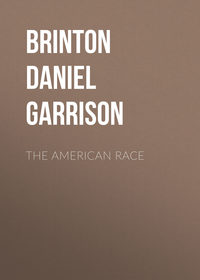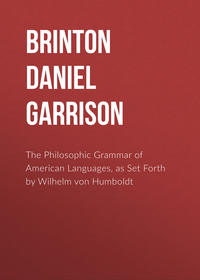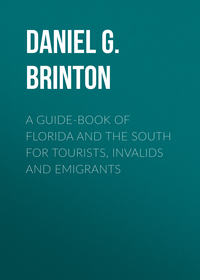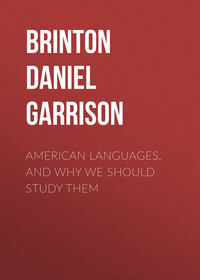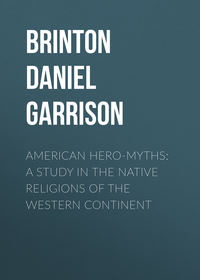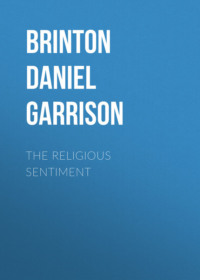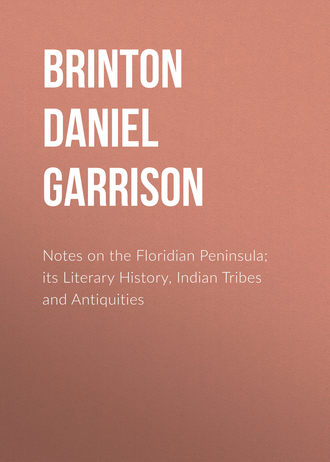 полная версия
полная версияNotes on the Floridian Peninsula; its Literary History, Indian Tribes and Antiquities
168
Hist. N. Am. Inds., p. 116.
169
Nat. Hist. of E. and W. Florida, pp. 71, 83.
170
Mems. Hist. sur la Louisiane, Tome II., p. 301.
171
George White, Hist. Colls. of Georgia, p. 423. It has also been described to me by a gentleman resident in the vicinity.
172
See the Christian Advocate and Journal for 1832, and the almost unintelligible abstract of the article in Josiah Priest’s American Antiquities, pp. 169, 170, (third edition, Albany, 1833.) Though the account is undoubtedly exaggerated, it would merit further investigation.
173
See Appendix II.
174
I give these according to the orthography of Baumgarten, who may differ slightly from other writers.
175
Oratio Dominica Polyglotta, Amstelædami, 1715. He does not state where he obtained them.
176
Hewitt, History of South Carolina, Vol. I. p 156.
177
El Cacique principal de Apalache, Superior de muchos Caciques, Barcia, Ensay. Cron., p. 323.
178
Roberts, Hist. of Florida, p. 14.
179
Schoolcraft’s Ind. Tribes, Vol. V. p. 259.
180
Schermerhorn, Report on the Western Indians in Mass. Hist. Colls. Vol. II. (2 ser.,) p. 26; Alcedo, Hist. and Geog. Dict. of America, Vol. I., p. 82.
181
Views of Louisiana, p. 150.
182
Trovarono terre grandi piene di genti molto ben disposte, savie, politiche, e ben’ ordinate. Bartolome de las Casas, Istoria della Distruttione dell’ Indie Occidentali, p. 108. Venetia, 1626.
183
Barcia, Ensay. Cron., p. 71.
184
Memoire, p. 13.
185
At what time or by whom Tampa Bay was first so called I have not been able to learn. Its usual name in early narratives is Baia de Espiritu Santo, which was given by De Soto; sometimes from separate discoveries it was called Bahia Honda (Deep Bay,) El Lago de San Bernardo, Baie de St. Louis, and by the Indiana Culata (Barcia, Ensayo Cron. p. 342, Torquemada, Monarquia Indiana, Lib. I., Cap. VI.) Herrera in his map of the Audiencia de la Española marks it “B. de tampa,” and after him Gerard a Schaagen in the Nov. et Accurat. Americæ Descriptio.
186
Williams, Hist. of Florida, pp. 36, 212. Ellicott’s Journal, p. 247. Robert’s Hist. of Florida, p. 17.
187
Guaicum officinale; the el palo or el palo santo of the Spaniards.
188
Barcia, En. Cron. Año 1566.
189
See Prior’s Journal in Williams’ Florida, p. 299. The name Miami applied to a tribe in Ohio, and still retained by two rivers in that State, properly Omaumeg, is said to be a pure Algic word, meaning, People who live on the peninsula. (Amer. Hist. Mag. Vol. III., p. 90.) We are, however, not yet prepared to accept this explanation as applicable to the word as it appears in Florida.
190
Barcia, Ensay. Cron., p. 49, and compare the Hist. Notable, p. 134.
191
For these facts see Fontanedo’s Memoire, passim, and Barcia, Años 1566, 1567.
192
Bernard Romans, pp. 291-2.
193
Desde los Martires al Cañaveral, Herrera, Dec. IV., Lib., IV., cap. VII.
194
Barcia (En. Cron. p. 118) says Ais commences twenty leagues up the St. Johns river; but distances given by the Spanish historians were often mere guesses, quite untrustworthy.
195
Basanier, Hist. Notable, pp. 133-4.
196
Vignoles, Obs. on the Floridas, pp. 74-5.
197
Biedma, Relation, p. 53; the Port. Gent. in Hackluyt, V., p. 492; La Vega, Lib. II., cap. x., p. 38.
198
Irving’s Conquest of Fla., p. 84, note.
199
Barcia, Año 1567; Fontanedo, pp. 20, 35.
200
Basanier, Hist. Notable, pp. 190-1, 108-9, 140 sq.
201
Jusqu’à Mayajuaca, dans la contrée de Ais, vers le lieu planté de roseaux. Fontanedo, Memoire, p. 35. Cañaveral is a Spanish word signifying the same as the expression I have italicised.
202
Basanier, Hist. Not. p. 90.
203
Ibid.
204
Basanier, Hist. Not. p. 8.
205
Hackluyt, Vol. V., p. 492, Fontanedo, p. 15.
206
Les Floridiens ne sement, ne plantent, ne prennent rien ni à la chasse, ni à la pêche, qui ne soit à la disposition de leurs chefs, qui distribuent, et donnent, comme il leur plait, etc. François Coreal, Voiages, Tome I., p. 44. The chiefs on the Bahamas possessed similar absolute power. (Peter Martyr, De Novo Orbe, Dec. VII., cap. I., p. 467.)
207
Basanier, Hist. Not., p. 132.
208
Basanier, pp. 9, 141.
209
Fontanedo, pp. 10, 11.
210
Basanier, Hist. Not. p. 7.
211
Travels, p. 456.
212
E. G. Squier, Aborig. Mon. of N. Y., App. pp. 135-7; Serpent Symbol, pp. 90, 94, 95.
213
Adair, Hist. N. Am. Inds., p. 205.
214
They came to meet Narvaez playing on such flutes, “tañendo unas Flautas de Caña,” Cabeza de Vaca, Naufragios, cap. V.
215
Bernard Romans, p. 62.
216
Francisco Ximenez, Origen de los Indios de Guatemala, p. 179.
217
De Morgues, Brevis Historia, Tab. XXI.
218
Lettre écrite par l’Adelantade Soto, etc., p. 46.
219
Brevia Historia, Tab. XXX., and compare the Histoire Memorable, p. 261.
220
Naufragios, cap. III.
221
God’s Protecting Providence, p. 62. This style of building was common among the Caribs, and may have been derived from them.
222
Basanier, Hist. Not., pp. 8, 101.
223
See Mackay, Progress of the Intellect, Vol. II., p. 143, note 152, and authorities there quoted.
224
Brevis Historia, Tab. XXXV.; Baumgarten, Geschichte von Amerika, B. I., s. 87.
225
Klemm, Culturgeschichte der Menscheit, B. II, s. 179.
226
Basanier, Hist. Not., pp. 43 sqq.
227
On the Trinity in aboriginal American religions, see Count Stolberg in the Wiener Yahrbücher der Literatur, B. XVI., s. 278.
228
God’s Protecting Providence, p. 12.
229
God’s Protecting Providence, pp. 38, 39.
230
Hist. of the North Am. Indians, p. 22. He embraces all tribes “from Hudson Bay to the Mississippi,” and adds that they had no lascivious or Priapean images or rites, in which he is equally at fault.
231
Man hat weder bei den Sudamericanern noch bei den Nördlichen eigentliche G ö t z e n b i l d e r oder I d o l e bemerkt. Culturgeschichte der Menschheit, B. II., s. 172. This is confined of course to the “Yägervolker.”
232
Barcia, Ensayo Cron. Año 1566, p. 94; the Port. Gent. in Hackluyt, Vol. V. p. 491, mentions this as existing among the tribes near Tampa Bay.
233
Moris apud illos est primogenitum masculum Regi victimum offerre, etc. Brevis Historia, Tab. XXXIV.
234
La Reprinse de la Floride, p. 264.
235
Wm. Bartram, Travels, p. 263, and compare Adair, Hist. of the North Am. Inds. pp. 238-9.
236
Brevis Historia, Tab. XL. Basanier, Hist. Not., pp. 10, 11.
237
Mackay, Progress of the Intellect, Vol. II., p. 129.
238
Tucururu or Tacatacuru was on the Atlantic coast south of St. Augustine, between it and Santa Lucea. (Barcia, En. Cron., p. 121.)
239
Hervas, Catalogo de las Lenguas de las naciones conocidas, Tom. I. p. 387. Madrid, 1800-1805.
240
Mithridates, oder Allgemeine Sprachenkunde, B. III., s. 285.
241
Gallatin, Trans. Am. Antiq. Soc., Vol. II., p. 178.
242
Basanier, Hist. Not. pp. 67, 69, 72; Coppie d’une Lettre venant de la Floride, p. 244.
243
Trans. Am. Antiq. Soc., Vol. II., p. 106.
244
Hewitt, Hist. of S. Car., Vol. I., p. 222. He gives 1714 as the date of this occurrence. But see Carroll’s Hist. Colls. of S. Car., Vol. II., p. 353.
245
On the Yemassees consult Hewitt, ubi suprà; Barcia, En. Cron. Año 1686; the tracts in Carroll’s Hist. Colls. of S. Car., Vol. II., pp. 106, 246, 353, 355; Roberts, Hist. of Florida, p. 15; Notices of E. Florida, by a recent traveller, p. 57.
246
On the migrations of this tribe consult the Colls. of the Georgia Hist. Soc. Vol. I., pp. 145-6; Vol. II., pp. 61, 71; John Filson; The Disc., Settlement, and Pres. State of Kentucké, App. 3, p. 84; Gallatin in Trans. Am. Antiq. Soc., Vol. II., pp. 84, 95; Notices of E. Fla., by a recent traveller, p. 59; Narrative of Oceola Nikkanoche, p. 70 et seq.; Moll’s Map of the Northern Parts of America, and Sprague’s Hist. of the Florida War.
247
Travels, pp. 388-9, and see p. 486.
248
Barcia, Ensayo Cronologico, Año 1686, p. 287.
249
Jedediah Morse, Rep. on Ind. Affairs, App. p. 93, Archæol-Amer., Vol. I., p. 273, and others.
250
Other forms of the same are Little St. Johns, Little Savanna, Seguano, Suannee, Swannee. It was also called the Carolinian river.
251
H. R. Schoolcraft, Notes on the Iroquois, p. 161. Adair, however, says they recorded themselves to be terræ filii. (Hist. N. Am. Inds., p. 257, but compare p. 195.)
252
For the individual nations composing the confederacy see Romans, Hist. of Fla., p. 90; Roberts, Hist. of Fla., p. 13, and Adair, p. 257.
253
Giddings (Exiles of Florida, p. 3) gives the incorrect translation “runaways,” and adds, “it was originally used in reference to the Exiles long before the Seminole Indians separated from the Creeks.” The Upper Creeks called them Aulochawan. (American State Papers, Vol. V., p. 813.)
254
Establishment of the Colony of Georgia, pp. 10, 12, in Peter Force’s Historical Tracts, Vol. I.
255
Major C. Swan, in Schoolcraft’s Hist. of the Indian Tribes. Vol. V., pp. 260, 272.
256
Smilax, China, and Zamia pumila.
257
On the civilization of the Seminoles, consult Wm. Bartram, Travels, pp. 192-3, 304, the American Jour. of Science, Vol. IX., pp. 133, 135, and XXXV., pp. 58-9; Notices of E. Fla., by a recent Traveller, and the works on the Florida War.
258
Narrative of Oceola Nikkanoche, p. 75. The author supposed this was to receive the injunctions of the dying mother, but more probably it sprang from that belief in a metasomatosis which prevailed, and produced analogous customs in other tribes. See La Hontan, Voiages, Tome I., p. 232; “Brebeuf, Relation de la Nouv. France pour l’an 1636, ch. IX.” Pedro de Cieza, Travs. in Peru, ch. XXXII., p. 86 in Steven’s Collection.
259
Notices of East Fla., by a recent traveller, p. 79. For the extent and meaning of this singular superstition, see Schoolcraft, Oneota, pp. 331, 456; Algic Researches, Vol. I., p. 149, note; Hist. of the Indian Tribes, Vol. III., p. 66; Gregg, Commerce of the Prairies, Vol. II., p. 271; Bradford, American Antiquities, p. 415; Mackay, Progress of the Intellect, Vol. I., p. 146, and note15.
260
Narrative of Oceola Nikkanoche, p. 77.
261
C. Swan in Schooloraft’s His. Ind. Tribes, Vol. V., p. 260.
262
By the whites I refer to the descendants of the English of the northern states. While under the Spanish government, up to the first Seminole war, their nation was said to be “numerous, proud and wealthy.” (Vignoles, Obs. on the Floridas, App., p. 215.) This was owing to the Spanish laws which gave them equal privileges with white and free colored persons, and drew the important distinction that they could hold land individually, but not nationally. How different these beneficent regulations from the decree of the Florida Legislature in 1827, that any male Indian found out of the reservation “shall receive not exceeding thirty-nine stripes on his bare back, and his gun be taken away from him.” (Laws relating to Inds. and Ind. Affairs, p. 247, Washington, 1832,) and similar enactments.
263
Relation de la Floride apportée par Frère Gregorio de Beteta, in Ternaux’s Recueil. They did not touch the coast beyond the Bay of Apalache nor much south of Tampa Bay. Both Barcia (En. Cron. Año 1549) and Herrera (Dec. VIII., Lib. V., cap. XIV., XV.) say they entered the latter, but this cannot be, as the supposed description is entirely inapplicable. For other particulars see Eden’s translation of Peter Martyr, (fol. 319, Londini, 1555.)
264
The authority for this, as well as most of the facts in this chapter where other references are not given, is Barcia’s Ensayo Cronologico.
265
Sometimes called Santa Maria or St. Marys; now Amelia Island, so named, from the beauty of its shores, by Gov. Oglethorpe in 1736. (Francis Moore, Voyage to Georgia, in Ga. Hist. Soc.’s Colls. Vol. I., p. 124)
266
Called by the natives Ylacco or Walaka, the river of many lakes; by the French Rivière Mai, as Ribaut entered it on the first of that month; by the Spaniards Rio Matheo, Rio Picolato, on some charts by mistake Rio San Augustin, Rio Matanca and Rio Caouita, and not till much later Rio San Juan, which the English changed to St. Johns, and St. Whan.
267
Barcia, p. 123, and cf., p. 128.
268
Williams, Florida, p. 175.
269
Though Drake left nothing but the fort, and the dwellings were a second time destroyed by Col. Palmer, in 1727, yet Stoddard (Sketches of Louisiana, p. 120) says houses were standing in his time bearing the date 1571!
270
Hackluyt, Vol. III., p. 432. Pedro Morales adds, “The greatest number of Spanyards that have beene in Florida these sixe yeeres, was 300.”
271
Torquemada, Monarquia Indiana, Lib. XIX., cap. XX., p. 350.
272
Nat. and Civ. Hist. of Fla., p. 175.
273
Torquemada, Monarquia Indiana, Lib. XIX., cap. XX., p. 350; Barcia, Años 1603 and 1612.
274
L’interieur, non plus que les parties de l’ouest et du Nord n’est pas en notre pouvoir. Voiages aux Indes Occidentales, T. I., p. 27.
275
He published two Cedulas Reales for this purpose, bearing the dates Oct. 20, 1680, and Sept. 30, 1687.
276
Barcia, p. 317; Careri, Voyage round the World, in Churchill’s Coll., Vol. IV., p. 537.
277
God’s Protecting Providence, pp. 77-8.
278
Maintenant ils sont presque touts Chrètiens. Louys Morery, Le Grand Dictionnaire Historique, ou le Melange Curieux, Vol. I., Art. Apalaches. (Amsterdam and La Haye, 1702.)
279
See the Report on Oglethorpe’s Expedition, and Col. Moore’s Letter to the Governor, in Carroll’s Hist. Colls. of S. C., Vol. II.
280
Williams, View of W. Fla., p. 107.
281
Alcedo, Dict. of America, Vol. I., p. 81.
282
God’s Protecting Providence, pp. 68-9.
283
Herman Moll, Thesaurus Geographus, Pt. II, p. 211, 4th ed. London, 1722.
284
Dickinson, God’s Protecting Prov., p. 63.
285
Roberts, Hist, of Fla., p. 15, and Francis Moore’s Voyage to Georgia.
286
Travels, p. 233.
287
Travels in E. Fla., p. 32, Darlington, Mems. of Bartram and Marshall, p. 284.
288
Nat. Hist. E. and W. Fla., pp. 277-8.
289
Nat. and Civil Hist. Fla. Preface and p. 175.
290
See his letter on the Antiquities of the State in Williams’ View of W. Fla., pp. 105-110.
291
The War in Fla., by a late Staff Officer, p. 5; see also, the account of Black Hoof in Morse’s Rep. on Ind. Affairs, App. p. 98, and cf. Archæol. Am., Vol. I. p. 273.
292
Dr. Stork, Des. of E. Fla., p. 8.
293
Capt. Robinson, in Roberts, p. 97.
294
Roberts, Hist. of Fla., p. 5.
295
Parliamentary History, Vol. XV., Col. 1301, Art. XX.
296
Travels, p. 65.
297
Jour. of Travels in E. Fla., p. 25.
298
Travels, p. 99.
299
Ibid., p. 521.
300
Travels, p. 99.
301
Au sorty du village d’Edelano, pour venir au port de la rivière il faut passer par une allée, longue environ de trois cens pas et large de quinze, aux deux costez de laquelle sont plantez de grands arbres, &c. Hist. Notable, p. 138.
302
Il y a au sortir du village une grande allée de trois à quatre cens pas, laquelle et recouverte de grands arbres des deux costez. Hist. Not. pp. 164-5.
303
Conq. de la Florida, Lib. II., P. I, cap. ult.
304
La Vega, Ibid., Lib. I., cap. V., pp. 30-1.
305
Lafitau in Baumgarten, Geschichte von Amerika, B. I., s. 71; Schoolcraft, Algic Researches, Vol. II., pp. 52, 190.
306
Knight, Anc. Art. sect. 162; Mackay, Progress of the Intellect, Vol I., p. 198, note28; Montfaucon, Antiquities, Vol. II, p. 235; Görres, Mythengeschichte, B. I., s. 171.
307
Real Cedula que contiene el asiento capitulado con Lucas Vasquez de Aillon, in Navarrete Viages, Tom. III. p. 153; Basanier, Hist. Notable, p. 29, and comp, p. 78.
308
Real cedula dando facultad à Francisco de Garay para poblar la Provincia de Amichel, in Navarrete, Tom. III., p. 148. The account says they were “de diez à once palmos en alto.”
309
Histoire de la Virginie, Liv. III., p. 259, (Orleans, 1707.)
310
Notes on the Iroquois, p. 482.
311
Letters from the Allegheny Mountains, Let. XX. p. 162.
312
Archæologia Americana, Vol. I.
313
On the rôle of trees in primitive religions consult Guigniaut, Religions de l’Antiquitè, T. I., pp. 81, 150, note, 391, 406.
314
La Vega, Conq. de la Florida, Lib. I., cap. IV., p. 5.
315
Ibid. Lib. III., cap. XIV., p. 129. cap. XV., p. 131, et sq.
316
For descriptions of this mode of interment, essentially the same in most of the tribes from the Mississippi to the St. Lawrence, and very widely prevalent in South America, consult Wm. Bartram, Travels, p. 516; Romans, Nat. Hist. Fla., pp. 88-90; Adair, Hist. N. Am. Inds., p. 183; Lawson, New Account of Carolina, p. 182, in Stevens’ Collection; Beverly, Hist. de la Virginie, pp. 259-62; Baumgarten, Ges. von Amerika, B. I., s. 470; Colden, Hist. of the Five Nations, p. 16, and many others.
317
See an instructive notice from Pere le Petit in the Lettres Edifiantes et Curieuses, T. IV., pp. 261-2, and the Inca, Lib. II., pp. 69-70; Lib. IV., p. 188; Lib. V., pp. 202, 231, &c.
318
Port. Gent, in Hackluyt, V., p. 489.
319
Nar. of Oceola Nikkanoche, pp. 71-2. The author speaks of one “that must have covered two acres of ground,” but this is probably a misapprehension.
320
I am aware that Mr. Schoolcraft places the pottery of Florida intermediate between the coarse work of the northern hunter tribes, and the almost artistic manufactures of Yucatan and Mexico, (see an article on the Antiquities of Florida, in the Hist. of the Ind. Tribes, Vol. III.;) but the numerous specimens obtained in various parts of the peninsula that I had opportunities to examine, never seemed to indicate a civilization so advanced.
321
There is an excellent paper on this topic by the well-known geologist, Lardner Vanuxem, in the Trans. Am. Assoc. Geol. and Naturalists, for 1840-42, p. 21. sq.
322
This is not an invariable proof however; see Tuomey, Geol. Survey of S. Car., p. 199, note.
323
Second Visit to the United States, Vol. I., p. 252.
324
Am. Jour. of Science, Vol. XI., (2 ser.) pp. 164-74.
325
Le case loro sono edificate di stuore sopra scorze d’ostriche, e sopra di esse dormono sopra cuoi d’animali. Relatione que fece Alvaro Nunez, detto Capo di Vaca, Ramusio, Viaggi, T. III., fol. 317., E.
326
On the geology of these bluffs, see the articles by Mr. Allen, in the first, and Mr. Conrad in the second volume of the Am. Jour. Science. (Second series.)
327
Travels, p. 198.
328
The peculiar hue of the whole St. Johns system of streams has been termed by various travellers a light brown, light red, coffee color, rich umber, and beer color. In the sun it is that of a weak lye, but in the shade often looks as black as ink. The water is quite translucent and deposits no sediment. The same phenomenon is observed in the low country of Carolina, New Jersey, and Lake Superior, and on a large scale in the Rio Negro, Atababo, Temi, and others of South America. In the latter, Humboldt (Ansichten der Natur, B. I., p. 263-4) ascribes it “to a solution of carburetted hydrogen, to the luxuriance of a tropical vegetation, and to the quantity of plants and herbs on the ground on which they flow.” In Florida, the vast marshes and hammocks, covered the year round with water from a few inches to two feet in depth, yet producing such rank vegetation as to block up the rivers with floating islands, are doubtless the main cause. The Hillsboro, Suwannee, and others, flowing through the limestone lands into the Gulf, are on the other hand remarkable for the clarity of their streams. I have drank this natural decoction when it tasted and smelt so strongly of decayed vegetable matter as almost to induce nausea. A fact not readily explained is that while the dark waters of other regions are marked by a lack of fish and crocodiles, a freedom from stinging musquitoes, a cooler atmosphere and greater salubrity, nothing of the kind occurs on these streams.




